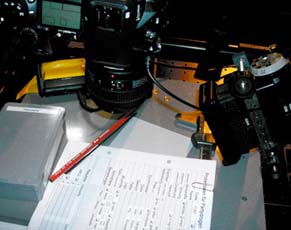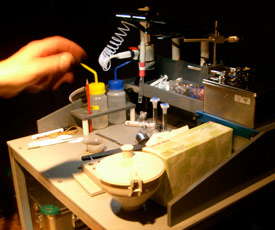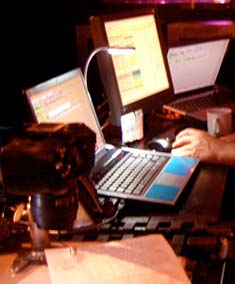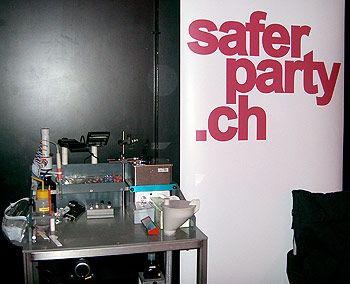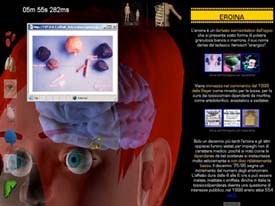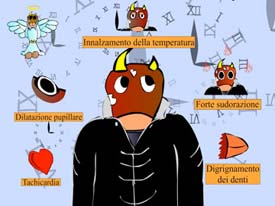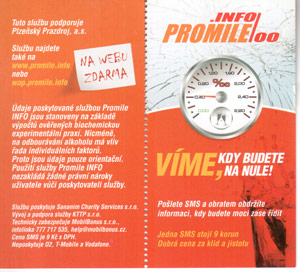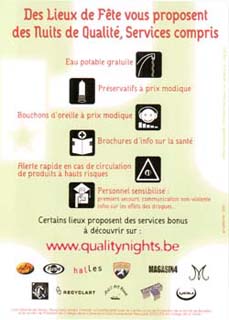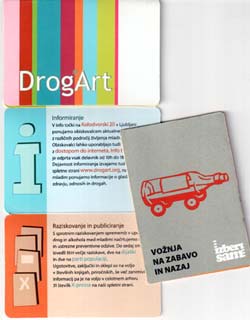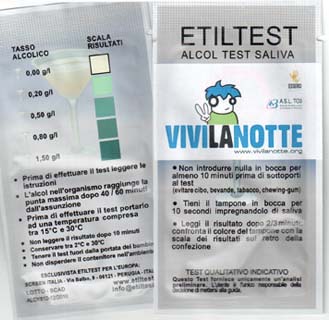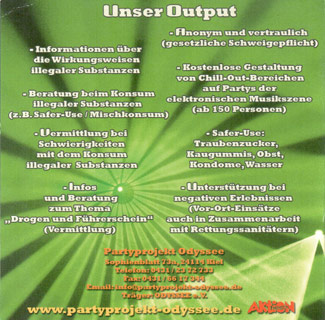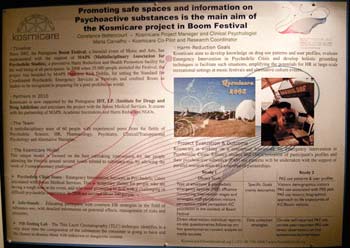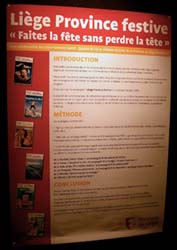Conference Report:
Club Health
6th International Conference on Nightlife, Substance Use and Related Health Issues, June 7-9, 2010
Aug 10, 2010
Citation: Thyssen S. "Club Health: 6th International Conference on Nightlife, Substance Use and Related Health Issues, June 7-9, 2010". Erowid.org. Aug 10, 2010. Erowid.org/general/conferences/conference_2010_clubhealth.shtml.

|
This year's major Club Health event, held in Zürich, Switzerland, covered the topics of alcohol and recreational drug use, peer education, (nightlife) policy, influence of and working with media, drug checking, drug trends (in particular research chemicals), safer transportation, violence prevention, sexual health, management and design of nightlife settings, therapeutic and medical (after)care of recreational drug users, and using the Healthy Nightlife Toolbox, which is a European Union international initiative offering best practices resources with respect to alcohol and drug use prevention that was launched at this year's Club Health. Plenary sessions and parallel workshops on these topics were complemented by posters that could be viewed during the breaks, as well as a model HPLC mobile drug-checking lab, and demonstrations of educational video games. Most talks were available in simultaneous translation (English, French, German). Many countries were represented, primarily from the European Union but also the Pacific Rim and the Americas, as well as the United Nations Office on Drugs and Crime (UNODC). While conference organizers made a sincere effort to have African countries represented, the 40 invitations they sent to potential speakers in African countries did not result in any participation. The conference organizers thoughtfully had the lunch breaks catered, which permitted participants to network on-site and helped keep the event on schedule. This report focuses on just a few of the trends, highlights, and novelties of Club Health 2010.
| Experience Counts: Research Chemical Self-Reports on Erowid.org (Conference Presentation Abstract) |
| The global research chemical phenomenon has only come to exist since the explosion of digital communication technologies. Today, anyone with full access to the Internet can feel like a participatory member of a drug culture featuring a constant stream of new materials, new packaging, and new ways of grey marketing that seem to keep one step ahead of law enforcement. The long-term health effects of these substances are unknown, and some products have been associated with deaths or lasting neurological problems and highly addictive effects. Confusing and sometimes conflicting data create a challenging arena for researching the health issues related to these compounds. The Internet abounds with self-reports describing the subjective effects of users' experiences with novel chemicals. Aside from documenting acute adverse events, self-reports offer an opportunity for information sharing prior to someone becoming a casualty. Since 1996, Erowid.org has been at the forefront of online publishing about research chemicals for which little information is otherwise coherently available. With over 10 million visitors per year, Erowid.org's reputation for reliable, non-judgmental reporting places it at a crossroads between users of novel psychoactive substances and public health efforts. This presentation will cover the ten-year evolution of the Erowid Experience Vaults as a vehicle for information related to risk reduction and health concerns vis-à-vis psychoactives substances, including over 65 so-called research chemicals. The history, philosophy, and practical challenges of collecting, reviewing, and categorizing a large number of first-person reports will be discussed. |
Erowid at Club Health
In my twenty-minute presentation, "Experience Counts: Research Chemical Self-Reports on Erowid.org", I gave an overview of Erowid, the report reviewing process, and the advantages, disadvantages, and challenges of experience reports as a vehicle for risk reduction and for documenting psychoactive use. I also served as moderator for a parallel workshop about drug checking that featured Paul Dargan of Guy's and St. Thomas' hospitals (London), Rainer Schmid of ChEckiT (Vienna), Hans-Jörg Helmlin of the mobile lab unit of the Office of the Cantonal Pharmacist, Health & Social Welfare Department, State of Bern (Switzerland), and Mireia Ventura of Energy Control (Barcelona). Through participation in Club Health, it was beneficial to Erowid's mission to have made more contacts among fieldworkers and researchers from many countries, and to learn details about developments in risk reduction, drug trends, and research outside the United States.Alcohol Problems Prevail
Paul Dillon of DARTA (Drug and Alcohol Research and Training Australia), a longtime and highly respected researcher at Club Health events, commented that over the years there has been a shift toward more presentations on alcohol and alcohol-related aggression, accidents, and other harms. A number of speakers described their findings on these topics. Rampant alcohol use is acute in European countries, particularly in the United Kingdom, where pre-loading on booze at home before going out, to avoid spending money on pricey drinks in clubs, is becoming more common. Brian Hayes of the London Ambulance Service, observed that individuals--rather than the environment in which they consume--are getting blamed for overconsuming, and yet the public health messaging oriented toward individuals is not grounded in evidence or evaluated for its effectiveness. Countries or municipalities where drinking establishments are open until early morning (or even round-the-clock) register more instances of sexual assault, fights, falls, and injuries from assault.Media Messages Examined
"The most dangerous drug isn't meow meow. It isn't even alcohol ... Newspapers are the biggest threat to the nation's mental wellbeing."
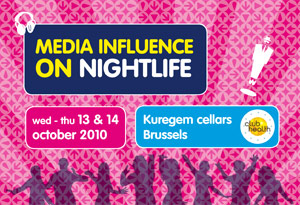
|
Drug Checking's High Standards
Typically, the drug checking performed by ChEckiT (Austria), Energy Control (Spain), and SaferParty (Switzerland) is only available in a context that puts users in contact with professional counselors. This has become a way for social workers and counselors to reach users and disseminate health-related information, especially to high-risk individuals who may not normally have contact with health professionals outside of emergency room contexts. An upcoming initiative, the Trans European Drug Information (TEDI) project, is designed to facilitate information sharing of warnings about unusual results in samples among EU drug checking groups.Representatives from the mobile lab unit of the Office of the Cantonal Pharmacist, Health & Social Welfare Department, State of Bern, Switzerland were on site with a full set of equipment, displaying the sophistication with which high-end risk reduction can be approached. Color-coded laptops and HPLC units, a camera station to photograph samples, and a balance station engineered to accurately weigh samples in a bass-intensive environment were all evidence that the Swiss approach provides an excellent model for on-site drug checking. While samples were not tested during the conference, the mobile lab could be seen in action at a party hosted on the last night of the event.
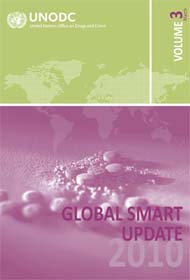
|
Amphetamine-Type Substances (ATS)
In his talk about the state of the global synthetic drug situation, Matthew Nice of the United Nations Office on Drugs and Crime presented a supra-national "30,000-foot view". The UNODC functions under a mandate from 192 member states. Nice works on the Global Synthetics Monitoring: Analyses, Reporting and Trends (Global SMART) Programme, launched in September 2008, which "targets capacity as needed", meaning, countries enlist the help of the UNODC in examining their specific drug problems, with an emphasis on supply reduction, by looking at statistics from a variety of sources (public health sources, customs seizures, and law enforcement reports). Nice described how, worldwide, "amphetamine-type substances (ATS)" users outnumber cocaine and heroin users combined, and ATS use is rising, especially quickly in developing countries, based on figures of past-year use. Saudi Arabia has a Captagon (fenethylline) problem, revealed by an increase in the number of people presenting for treatment for stimulant abuse. New countries are reporting ATS, even those that used to just report opiates, like Iran. Organized crime syndicates are getting into synthetic drug production. Large-scale mephedrone production, for example, has organized crime associations. Nice also commented that ketamine use is exploding in Southeast Asia, a comment confirmed by a conference participant who teaches public health at a Hong Kong university.Research Chemicals: All Over the Map
New substances continue to appear, making policing them as well as understanding their public health implications more and more complex. At least a dozen speakers touched on some aspect of research chemicals, and two parallel workshops focused on them. The mephedrone phenomenon in the United Kingdom received particular attention.Rainer Schmid of ChEckiT (Vienna, Austria), described how an increasing variety of substitutes for MDMA are entering the ecstasy market, which was confirmed by other drug checking groups. He described research chemicals as a "pharmacological and toxicological nightmare", and commented that, "Maybe prohibition is not so efficient, in part because it makes prevention impossible". Schmid added during his talk that he would never recommend Marquis reagent tests: the proliferation of similar compounds has made these of limited use.
David Wood, clinical toxicologist at Guy's and St. Thomas' hospitals in London,3 has seen dozens of cases presenting at London emergency rooms following mephedrone ingestion since patients first started self-reporting use of this substance in January 2009. Wood says they don't routinely do comprehensive toxicological screening in emergency rooms, since screening for epidemiological purposes requires extra funding. A typical drug screen won't pick up something like 4-methylmethcathinone, which, given that it is a fairly new recreational substance, requires a specialized test. People presenting at hospital have often reported having taken the same doses as people who had normal effects. Wood observed that since mephedrone's ban, there has not been a drop-off in the number of related hospitalizations, even though it's been controlled. Unfortunately, while basic research is needed to understand this substance, the prohibition of 4-methylmethcathinone in the United Kingdom has made studying it in animals for pharmacokinetic and other data much more difficult. Immunoassay tests may not be worth developing for any particular research chemical because of the speed of the market as it churns out new drugs, and because of the high risk of false positives. True epidemiological information requires GC/MS data and other expensive measures. Wood's colleague, Paul Dargan, clinical director for toxicology at Guy's and St. Thomas', observed that the World Health Organization is very poor for coding for recreational drugs, especially novel compounds, and that research chemicals are also not mentioned in national surveys.

|
European Monitoring
Dominique Lopez, scientific analyst with the European Monitoring Centre for Drugs and Drug Addiction, reported on the monitoring of online sales of legal alternatives to illicit drugs. The EMCDDA gathers lots of drug data, including prices of illicit substances and legal highs. Since 2006, it has adopted the "snapshots of the Internet" methodology borrowed from the Psychonaut Web Mapping Project group.4 The EMCDDA's 2010 "snapshot" showed 170 different "legal highs" available, including GHB-type substances and "magic mushrooms". Health information/warnings appeared on one-third of the sites. More often than not, info on ingredients was not useful, and no details were provided on a product's legal status, though there was information on what the best-selling products were. They also found that legal highs might not necessarily be cheaper than illegal substances. Newly released products are on the higher-priced end of the scale. Lopez mentioned specific research, such as the German MoSyD (Drug Trends Monitoring System) survey5 conducted in Frankfurt, Germany, which revealed that 15-18-year-olds were using Spice products to avoid cannabis-related penalties while driving. Lopez also talked about mephedrone and how media coverage is likely to be linked with increased awareness among the general population and possible increase in users.| Swiss Drug Checking Mobile Unit - Snapshots | ||||||||
The mobile lab was set up on-site at Club Health, with technicians available to explain the components. Color-coded laptops match the color-coded HPLC units, permitting two samples to be tested simultaneously. As part of the intake process, a sample is photographed and weighed while a client fills out an information sheet about it.
|
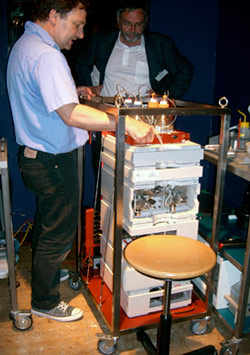
|
On-site Drug Checking
Hans-Jürg Helmlin, head of the mobile lab unit of the Office of the Cantonal Pharmacist, Health & Social Welfare Department, State of Bern, Switzerland, discussed the on-site analysis of street drugs via HPLC-DAD that his group has been doing, in cooperation with Streetwork Zürich and Contact Bern. In Switzerland -- as well as Spain and Vienna -- showing up at parties and doing analytical testing is perceived by the general public as a credible harm reduction approach, acting as a vehicle to effectively deliver counseling. With the multiplicity of substances, providing more specific data about them makes an impression on users. While Austrian law prohibits operators of drug checking equipment to touch samples, this restriction does not exist for Swiss drug checking.As of May 2010, the Swiss lab has run 1710 tests from 115 parties since it first started analyzing in 1998.6 A sample of Helmlin's observations gleaned from analyzing drug samples: when mCPP was causing all-night vomiting, vendors began adding an antiemetic to tablets; there is a large variety in results from capsules; for powder samples, if the number of amphetamine samples submitted for analysis goes up, the number of cocaine samples go down; if a Swiss tablet contains MDMA, it has about 80 mg; the cocaine content of powder sold as cocaine is going down.
Mireia Ventura of Energy Control (Spain)7 described the group's practices, including the fact that Energy Control follows up the release of their analysis results with voluntary online surveys that users can complete. Ventura also confirmed that bringing drug checking to parties facilitates contact between users of certain drugs and counseling. In Barcelona, users can drop in to Energy Control's office, outside of a party context, which permits them to develop rapport with drug counselors over time. Those who perform drug checking can alert users to risks associated with changing modes of administration (e.g. insufflation vs. oral) because of the shift from pills to powders. Energy Control has moved toward sending press releases about certain drug-supply trends and risk reduction approaches to the media. Some highlights of Ventura's observations: more ketamine and research chemicals are showing up in samples; a lack of MDMA in ecstasy samples was correlated with an increase of mCPP appearing in tablets; in the first quarter of 2010, 67% of cocaine samples tested by Energy Control showed up adulterated with levamisole.8
A sampling of initiatives and groups represented at Club Health 2010:
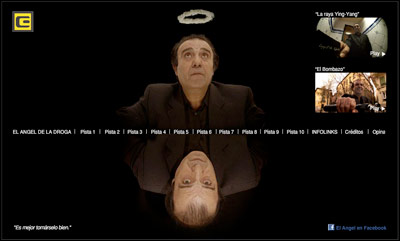
|
Featuring the Safer NightLife digital library of risk reduction documents (fliers, trainings materials, evaluation tools, research articles, protocols, etc.) from associated fieldwork projects. The documents are compiled in their original languages, and translations are provided or planned for many.

|
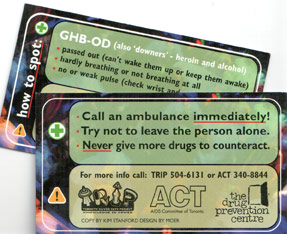
|
A long-established Swiss harm reduction group, Eve&Rave features an online forum. Posts can serve as early warning trends for risk reduction groups. They exchange information within Europe, for example with Energy Control.
Videogames developed for prevention and harm reduction by the Human Technology Lab, University of Padua, under the guidance of Prof. Luciano Gamberini. This group of psychology researchers develops "serious games": educational videogames that teach about the effects of psychoactive drugs. They set up Videodope at parties, where users can measure their knowledge about psychoactives as they play a game on a giant screen. (Happy Farm, appropriate for young teens, is implemented in non-party settings such as after-school programs.) On-site counselors facilitate the game-playing and interact with players, since the games stimulate discourse about drug effects. The counselors can customize slang for regional variation. The amount of time spent playing can modify a game's effects; longer playing allows the participant to go more deeply into information about particular substances; less time spent in play, for example if there are many people waiting in line to play, makes it a more social experience, where the game and the issues it raises become the topic of conversation. These games are not available for unsupervised play, because the objective is to bring users into contact with counselors and provide information in a lively social context. Automatic data collection and analysis (for factors like gender and which drugs are selected within the game's menus) provide feedback for the researchers as they are developing Videodope and Happy Farm. Next steps for this team: creating multi-language, multicultural versions of games. I had the opportunity to play the games and discuss them with one of the University of Padua researchers who facilitates them at parties and in other contexts. Engaging and cleverly rendered, their messaging is credibly oriented toward risk reduction and prevention. (Video shorts showing each game in action are viewable on YouTube.)
|
|
Summary
The organizers of this Club Health offered a unique twist to the event's conclusion: they charged Isabelle Jacobi, editor of the prime-time Swiss National Public Radio news magazine Echo der Zeit [Echo of the Times] with giving a journalistic summary of the event.
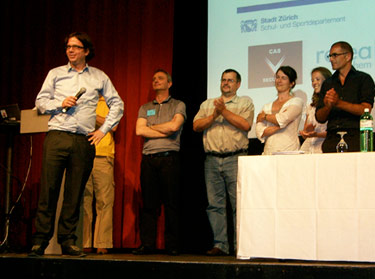
|
Ultimately, Club Health participants would agree that credibility is vital for prevention, and that exchange of knowledge on best practices and evaluation are crucial. Supra-national agencies and collaborations (EMCDDA; UNODC; Democracy, Cities and Drugs) are ports of data collection. Finally, Jacobi opined that maybe the trends of the Internet drug market will result in more clarity of governmental policies. She pointed out that future changes in policy are uncertain because no politician wants to raise the issue of (il)legality; politically things will get messier because prohibition is a popular platform.
While there are clearly severe public health and safety consequences that result from certain behaviors and practices in nightlife/club contexts, there was a "when you're a hammer every problem is a nail" theme among some of the researchers that in some cases left an impression of extreme circumstances generalized to clubbing in general. Nightlife patrons who don't get into crisis seemed nearly invisible, at least in the talks I attended. But the tone of the conference was overall as congenial as it was diverse; nowhere have I been to an event that so fully integrated across disciplines and professions.
| Risk Reduction Literature from Participants of Club Health 2010 | ||||||||
|
| Poster Presentations at Club Health 2010 | ||
|
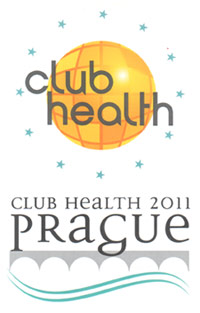
|
Links #
- El Angel de la Droga (Energy Control project)
- ChEckiT, Austrian drug checking
- Club Health International Conference
- Club Health Project
- Democracy Cities & Drugs participating groups
- Drug and Alcohol Research and Training Australia
- Energy Control, Spanish risk reduction group
- European Monitoring Centre for Drugs and Drug Addiction
- European Safer Nightlife Digital Library
- Eve & Rave, Swiss harm reduction group
- Healthy Nightlife Toolbox
- The Online Assessment of Substance use Information and Support (OASIS)
- TRIP! Project, Canadian harm reduction group
- United Nations Office on Drugs and Crime, Global SMART Programme
Notes #
- Club Health 2008 is described in Measham F, Anderson T, Hadfield P. "Club health: global perspectives, new directions". Adicciones. 2009;21(4):259-63.
- See Forsyth AJ. "A design for strife: alcopops, licit drug - familiar scare story". Int J Drug Policy. 2001 Apr 28;12(1):59-80.
- David Wood and Paul Dargan have published on the toxicology and chemical analysis of research chemicals.
- The Psychonaut Web Mapping Project.
- Centre for Drug Research, German MoSyD (Drug Trends Monitoring System).
- See Allemann D, Pauli H, Mürner A, Helmlin HJ and Steiner S. "Substance Testing on the Dance Floor with a Mobile High-tech Lab". Club Health 2010, Poster. Jun 2010.
- Energy Control's thin layer chromatography techniques were featured in an article in Erowid Extracts #15.
- See Cocaine Adulterated with Levamisole on the Rise.
- Human Technology Lab (http://htlab.psy.unipd.it) - See also Designing a serious game for young users: the case of happy farm and introductions to Videodope and Happy Farm on YouTube.


